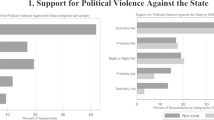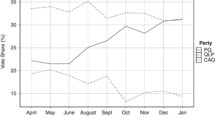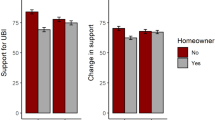Abstract
The red-blue state and urban–rural narratives—which depict that people living in red states and rural areas oppose pro-LGB policies—are popular frames for describing variation in public opinion of LGB policies by geographic region. In a test case of a red state, we examine public opinion of pro-LGB policies to assess the accuracy of the red–blue and urban–rural narratives. Using data from a survey of Nebraskans (n = 1608), we found that public opinion was more nuanced than the red state narrative allows but that urban and rural respondents reported significantly different opinions of pro-LGB policies. Rural people, however, were not unsupportive of all pro-LGB policies. Among all Nebraskans, support was higher for policies to protect LGB people from housing and job discrimination while support was lower for marriage and adoption rights. We discuss what these findings mean for public policy, urban and rural LGB individuals, and future public opinion studies of LGB issues.
Similar content being viewed by others
Notes
Nebraska, however, split its Electoral College votes by congressional district in the 2008 election. President Obama won the vote in Nebraska’s second congressional district and received one electoral vote from Nebraska.
The question about support for DOMA had the highest item missing rate. We hypothesize that more respondents skipped this question than normally would have because the US Supreme Court ruled parts of the law unconstitutional in the middle of the NASIS 2013 field period. Comments that some respondents wrote next to unanswered questions about DOMA anecdotally suggest that this may explain the higher item non-response rate.
References
Abramowitz, A. I., & Saunders, K. L. (2008). Is polarization a myth? The Journal of Politics, 70(2), 542–555.
Abrams, S, & Fiorina, MP (2012). “The Big Sort” that wasn’t: a skeptical reexamination. PS: Political Science & Politics, 45(2), 203–210.
Adam, B. D. (2003). The Defense of Marriage Act and American exceptionalism: the “gay marriage” panic in the United States. Journal of the History of Sexuality, 12(2), 259–276.
American Association for Public Opinion Research (2009). Standard definitions: final dispositions of case codes and outcomes for surveys. 6th edition. AAPOR. Retrieved from http://www.aapor.org.
Andersen, R., & Fetner, T. (2008). Cohort differences in tolerance of homosexuality: attitudinal change in Canada and the U.S., 1981–2000. Public Opinion Quarterly, 72, 311–330.
Atkeson, L. R., Adams, A. N., & Alvarez, R. M. (2014). Nonresponse and mode effects in self- and interviewer-administered surveys. Political Analysis, 22(3), 304–320.
Baunach, D. M. (2012). Changing same-sex marriage attitudes in America from 1988 through 2010. Public Opinion Quarterly, 76(2), 364–378.
Becker, A. B. (2014). Employment discrimination, local school boards, and LGBT civil rights: reviewing 25 years of public opinion data. International Journal of Public Opinion Research, 26(3), 342–354.
Becker, A., & Scheufele, D. (2011). New voters, new outlook? Predispositions, social networks, and the changing politics of gay civil rights. Social Science Quarterly, 92(2), 324–345.
Bishin, B., & Smith, A. (2013). When do legislators defy popular sovereignty? Testing theories of minority representation using DOMA. Political Research Quarterly, 66(4), 794–803.
Bishop, B. (2004). The big sort: why clustering of like-minded America is tearing us apart. New York: First Mariner Books.
Bobo, L. D., & Charles, C. Z. (2009). Race in the American mind: from the Moynihan report to the Obama candidacy. The ANNALS of the American Academy of Political and Social Science, 621(1), 243–259.
Bostwick, W. B., Boyd, C. J., Hughes, T. L., & McCabe, S. E. (2010). Dimensions of sexual orientation and the prevalence of mood and anxiety disorders in the United States. American Journal of Public Health, 100, 468–475.
Brewer, P. R., & Wilcox, C. (2005). Same-sex marriage and civil unions. Public Opinion Quarterly, 69(4), 599–616.
Brumbaugh, S. M., Sanchez, L. A., Nock, S. L., & Wright, J. D. (2008). Attitudes toward gay marriage in states undergoing marriage law transformation. Journal of Marriage and Family, 70, 345–359.
Burdge, B. (2009). Legal discrimination against lesbian, gay, and bisexual employees: a multi-theoretical model to explain an elusive civil rights law. Journal of Policy Practice, 8, 4–20.
Bureau of Sociological Research. (2013). NASIS 2012–2013 methodology report.
Burnett, R. C., & Salka, W. M. (2009). Determinants of electoral support for anti-gay marriage: an examination of 2006 votes on ballot measures in the states. Journal of Homosexuality, 56(8), 1071–1082.
Carter, J. (2008). A cosmopolitan way of life for all? A reassessment of the impact of urban and region on racial attitudes from 1972 to 2006. Journal of Black Studies, 40(6), 1075–1093.
Carter, J., & Borch, C. (2005). Assessing the effects of urbanism and regionalism on gender-role attitudes, 1974–1998. Sociological Inquiry, 75(4), 548–563.
Davis, M. A. (2013). Demographics of gay and lesbian adoption and family policies. In A. K. Baumle (Ed.), International handbook on the demography of sexuality (pp. 383–403). New York: Springer.
Dejka, J. (2014). Heineman seeks ed board applicants’ views on gay adoption, Obamacare, immigrant tuition. Omaha World-Herald. Retrieved from http://www.omaha.com.
de Leeuw, E. D. (2008). Choosing the method of data collection. In E. D. de Leeuw, J. J. Hox, & D. A. Dillman (Eds.), International handbook of survey methodology (pp. 113–135). New York: Psychology Press.
Dimock, M., Doherty, C., & Kiley, J. (2013). Growing support for gay marriage: changed minds and changing demographics. Washington, DC: Pew Research Center.
Drumheller, K., & McQuay, B. (2010). Living in the buckle: promoting LGBT outreach services in conservative urban/rural centers. Communication Studies, 61(1), 70–86.
Eldridge, V. L., Mack, L., & Swank, E. (2006). Explaining comfort with homosexuality in rural America. Journal of Homosexuality, 51(2), 39–56.
England, P. (2010). The gender revolution uneven and stalled. Gender & Society, 24, 149–166.
Fischer, C. S. (1975). Toward a subcultural theory of urbanism. American Journal of Sociology, 80(6), 1319–1341.
Fiorina, M. P., Abrams, S. A., & Pope, J. C. (2008). Polarization in the American public: misconceptions and misreadings. The Journal of Politics, 70(2), 556–560.
Fiorina, M. P., Abrams, S. J., & Pope, J. C. (2006). Culture war? The myth of a polarized America. New York: Pearson-Longman.
Flores, AR, & Barclay, S (2015). Trends in public support for marriage for same-sex couples by state. The Williams Institute. Retrieved from http://www.williamsinstitute.law.ucla.edu.
Freedom to Marry (n.d.). States. Available online at <http://www.freedomtomarry.org/states>. Accessed September 1, 2015.
Friedman, S, Reynolds, A, Scovill, S, Brassier, FR, Campbell, R, & Ballou, M (2013). An estimate of housing discrimination against same-sex couples. Office of Policy Development and Research. US Department of Housing and Urban Development. Retrieved from http://www.huduser.gov/portal/Publications/pdf/Hsg_Disc_against_SameSexCpls_v3.pdf.
Funk, J (2013, December 31). Most Nebraska schools to offer same-sex benefits. Associated Press
Gates, G. J. (2013). Geography of the LGBT population. In A. K. Baumle (Ed.), International handbook on the demography of sexuality (pp. 229–242). New York: Springer.
Gates, G. J., & Newport, F. (2013). LGBT percentage highest in DC, lowest in North Dakota. North Dakota: Gallup.
Gebelhoff, R, & Leonhardt, D (2014, August 23). The growing blue-state diaspora. The New York Times. Retrieved from http://www.nytimes.com
Ghaziani, A. (2014). Measuring urban sexual cultures. Theoretical Sociology, 43, 371–393.
Glissmann, B. (2013, December 22). Starting in 2014, some Nebraska hospitals will cover same-sex couples. Omaha World Herald. Retrieved from http://www.omaha.com.
Goldberg, A. E., & Allen, K. R. (2013). Donor, dad, or…? Young adults with lesbian parents’ experiences with known donors. Family Process, 52, 338–350.
Grace, E. (2012, October 4). World-Herald Poll: majority now back recognition of gay unions. Omaha World-Herald. Retrieved from http://www.omaha.com.
Haider-Markel, D. P., & Joslyn, M. R. (2008). Attributions and the regulation of marriage: considering the parallels between race and homosexuality. Political Science Politics, 38, 233–239.
Hatzenbuehler, M. L., Bellatorre, A., Lee, Y., Finch, B. K., Muennig, P., & Fiscella, K. (2014). Structural stigma and all-cause mortality in sexual minority populations. Social Science & Medicine, 103, 33–41.
Hatzenbuehler, M. L. (2010). Social factors as determinants of mental health disparities in LGBT populations: implications for public policy. Social Issues and Policy Review, 4, 31–62.
Herek, G. M. (2009). Sexual stigma and sexual prejudice in the United States: a conceptual framework. In D. A. Hope (Ed.), Contemporary perspectives on lesbian, gay, and bisexual identities: the 54th Nebraska Symposium on Motivation (pp. 65–111). New York: Springer.
Hicks, N. (2013). No vote in sight for Lincoln’s fairness ordinance. Lincoln: Lincoln Journal Star.
Hopkins, J. J., Sorensen, A., & Taylor, V. (2013). Same-sex couples, families, and marriage: embracing and resisting heteronormativity. Sociology Compass, 7(2), 97–110.
Hunter, J. D. (1991). Culture wars: the struggle to define America. New York: Basic Books.
Kazyak, E. (2011). Disrupting cultural selves: constructing gay and lesbian identities in rural locales. Qualitative Sociology, 34(4), 561–581.
Kazyak, E. (2012). Midwest or lesbian? Gender, rurality, and sexuality. Gender & Society, 26(6), 825–848.
Kazyak, E. (2015). “The Law’s the Law, Right?” Sexual minority mothers navigating legal inequities and inconsistencies. Sexuality Research and Social Policy, 12, 188–201.
Kiley, J. (2014). 61% of young Republicans favor same-sex marriage. Pew Research Center. Retrieved from http://www.pewresearch.org
Klinkner, P. (2004). Red and blue scare: the continuing diversity of the American electoral landscape. The Forum: A Journal of Applied Research in Contemporary Politics, 2(2), Article 2.
Lax, J. R., & Phillips, J. H. (2009). Gay rights in the states: public opinion and policy responsiveness. American Political Science Review, 103(3), 367–386.
Levendusky, M. S., & Pope, J. C. (2011). Red states vs. blue states: going beyond the mean. Public Opinion Quarterly, 75(2), 227–248.
Lewis, G. B., & Gossett, C. W. (2008). Changing public opinion on same-sex marriage: the case of California. Politics & Policy, 36, 4–30.
Lewis, G. B. (2005). Black-white differences in attitudes toward homosexuality and gay rights. Public Opinion Quarterly, 67, 59–78.
Lewis, G. B. (2011). The friends and family plan: contact with gays and support for gay rights. The Policy Studies Journal, 39(2), 217–238.
Lewis, G. B., & Rogers, M. A. (1999). Does the public support equal employment rights for gays and lesbians? In E. Riggle & B. Tadlock (Eds.), Gays and lesbians in the democratic process: public policy, public opinion, and political representation (pp. 118–145).
Lewis, G. B., Rogers, M. A., & Sherrill, K. (2011). Lesbian, gay, and bisexual votes in the 2000 U.S. Presidential Election. Politics & Public Policy, 39(5), 655–677.
Lipka, M. (2014). Gay marriage arrives in the South, where the public is less enthused. Pew Research Center. Retrieved from http://www.pewresearch.org.
Maher, J. (2015). Welcome to my homophobic state. Retrieved from: http://gawker.com/welcome-to-my-homophobic-state-1696050912.
Martin, B. (2014). Sponsor of workplace sexual orientation bill encouraged. Nebraska Radio Network Retrieved from http://www.nebraskaradionetwork.com.
McCarthy, J. (2014). Same-sex marriage support reaches new high at 55%. Gallup. Retrieved from http://www.gallup.com.
Meyer, I. H. (1995). Minority stress and mental health in gay men. Journal of Health & Social Behavior, 36, 38–56.
Meyer, I. H. (2003). Prejudice, social stress, and mental health in lesbian, gay, and bisexual populations: conceptual issues and research evidence. Psychological Bulletin, 129, 674–697.
Moore, M. R., & Stambolis-Ruhstorfer, M. (2013). LGBT sexuality and families at the start of the twenty-first century. Annual Review of Sociology, 39, 491–507.
Morrison, MA, Morrison, TG, & Franklin, R. (2009). Modern and old-fashioned homonegativity among samples of Canadian and American university students. Journal of Cross-Cultural Psychology, 40(4), 523–542.
O’Connor, M. (2013, April 9). Polls show shift on same-sex marriage, but local foes don’t lose heart. Omaha World-Herald. Retrieved from http://www.omaha.com.
Olson, L. R., Cadge, W., & Harrison, J. T. (2006). Religion and public opinion about same-sex marriage. Social Science Quarterly, 87(2), 340–360.
Oswald, R. F., & Lazarevic, V. (2011). “You live where?!” Lesbian mothers’ attachment to nonmetropolitan communities. Family Relations, 60(4), 373–386.
Patterson, R. G., & Riskind, C. J. (2010). Parenting intentions and desires among childless lesbian, gay, and heterosexual individuals. Journal of Family Psychology, 24(1), 78–81.
Pearl, M., & Galupo, M. P. (2007). Development and validation of the attitudes toward same-sex marriage scale. Journal of Homosexuality, 53(3), 117–134.
Pew Research Center (2013a). Growing support for gay marriage: changed minds and changing demographics. Retrieved from http://www.pewresearch.org.
Pew Research. (2013b). In gay marriage debate, both supporters and opponents see legal recognition as ‘inevitable.’. Retrieved from http://www.pewresearch.org.
Pew Research. (2014a). Changing attitudes on gay marriage. Pew Research Center. Retrieved from http://www.pewresearch.org.
Pew Research. (2014b). Political polarization in the American public: how increasing ideological uniformity and partisan antipathy affect politics, compromise, and everyday life. Retrieved from http://www.pewresearch.org.
Pizer, J. C., Sears, B., Mallory, C., & Hunter, N. D. (2012). Evidence of persistent and pervasive workplace discrimination against LGBT people: the need for Federal legislation prohibiting discrimination and providing for equal employment benefits. Loyola Law School Review, 45, 715–779.
Pluhacek, Z. (2015). Nebraska bill to add LGBT workplace protections tabled for year. Lincoln: Lincoln Journal Star.
Powell, B., Bolzendahl, C., Geist, C., & Steelman, L. C. (2010). Counted out: same-sex relations and Americans’ definitions of marriage. New York: Russell Sage.
Raeburn, N. C. (2004). Working it out: the emergence and diffusion of the workplace movement for lesbian, gay, and bisexual rights. In D. J. Myers & D. M. Cress (Eds.), Authority in contention (pp. 187–230). Amsterdam: Elsevier.
Rasmussen, C. E. (2006). We’re no metrosexuals: identity, place, and sexuality in the struggle over gay marriage. Social & Cultural Geography, 7(5), 807–825.
Rauch, J. (2014, June 15). Red America’s anti-gay backlash. The Daily Beast. Retrieved from http://www.thedailybeast.com
Reed, L. (2012, June 9) NU to insure domestic partners. Omaha World Herald. Retrieved from http://www.omaha.com
Reuters. (2012). Omaha narrowly approves law to protect gays from discrimination
Rowatt, W. C., LaBouff, J., Johnson, M., Froese, P., & Tsang, J. (2009). Associations among religiousness, social attitudes, and prejudice in a national random sample of American adults. Psychology of Religion and Spirituality, 1, 14–24.
Saad, L. (2013). In the US, blue states outnumber red states, 20 to 12. Gallup. Retrieved from http://www.gallup.com
Salka, W. M., & Burnett, R. C. (2011). Determinants of electoral support for anti-gay marriage constitutional amendments: an examination of ballot issues in California and Florida. Sexuality & Culture, 16(1), 59–75.
Schwartz, J. (2010). Investigating differences in public support for gay rights issues. Journal of Homosexuality, 57, 748–759.
Seidman, S. (2002). Beyond the closet: the transformation of gay and lesbian life. New York: Routledge.
Shapiro, J. (2013). The law governing LGBT-parent families. In A. E. Goldberg & K. R. Allen (Eds.), LGBT-parent families (pp. 291–307). New York: Springer.
Sherkat, D. E., de Vries, K. M., & Creek, S. (2010). Race, religion, and opposition to same-sex marriage. Social Science Quarterly, 91, 80–98.
Silver, N. (2013, March 26). How opinion on same-sex marriage is changing, and what it means. New York Times. Retrieved from http://www.nytimes.com.
Snively, C. A., Kreuger, L., Stretch, J. J., Wilson Watt, J., & Chadha, J. (2004). Understanding homophobia: preparing for practice realities in urban and rural settings. Journal of Gay & Lesbian Social Services, 17(1), 59–81.
Spring, A. (2013). Declining segregation of same-sex partners: evidence from the census 2000 and 2010. Population Research and Policy Review, 32(5), 687–716.
Stange, M. (2014). Tailoring general population surveys to address participation and measurement challenges of surveying lesbian, gay, and bisexual people. Doctoral dissertation. Lincoln: University of Nebraska.
Stoddard, M. (2014). Nebraska legislature: pressure will be on in short session. Omaha: Omaha World Herald.
Stone, AL. (2012). Gay rights at the ballot box. Minneapolis: University of Minnesota Press
Swank, E., Fahs, B., & Frost, D. M. (2013a). Region, social identities, and disclosure practices as predictors of heterosexist discrimination against sexual minorities in the United States. Sociological Inquiry, 83(2), 238–258.
Swank, E., Frost, D., & Fahs, B. (2012). Rural location and exposure to minority stress among sexual minorities in the United States. Psychology & Sexuality, 3(3), 226–243.
Swank, E., Woodford, M. R., & Lim, C. (2013b). Antecedents of pro-LGBT advocacy among sexual minority and heterosexual college students. Sexuality Research & Social Policy, 10, 317–332.
Tuch, S. A. (1987). Urbanism, region, and tolerance revisited: the case of racial prejudice. American Sociological Review, 52(4), 504–510.
Walls, N. E. (2008). Toward a multidimensional understanding of heterosexism: the changing nature of prejudice. Journal of homosexuality, 55(1), 20–70. (4), 523–542.
Walsh, K. C. (2012). Putting inequality in its place: rural consciousness and the power of perspective. American Political Science Review, 106(3), 517–532.
Weinberg, J. D., Freese, J., & McElhattan, D. (2014). Comparing data characteristics and results of an online factorial survey between a population-based and a crowd source-recruited sample. Sociological Science, 1, 292–310.
Whitehead, A. L. (2010). Sacred rites and civil rights: religion’s effect on attitudes toward same-sex unions and the perceived cause of homosexuality. Social Science Quarterly, 91, 63–79.
Wienke, C., & Hill, G. J. (2013). Does place of residence matter? Rural-urban differences and the wellbeing of gay men and lesbians. Journal of Homosexuality, 60, 1256–1279.
Wilson, T. C. (1985). Urbanism and tolerance: a test of some hypotheses drawn from Wirth and Stouffer. American Sociological Review, 50(1), 117–123.
Wirth, L. (1938). Urbanism as a way of life. American Journal of Sociology, 44(1), 1–24.
Woodford, M. R., Chonody, J., Scherrer, K., Silverschanz, P., & Kulick, A. (2012). The “persuadable middle” on same-sex marriage: formative research to build support among heterosexual college students. Sexuality Research & Social Policy, 9(1), 1–14.
Acknowledgment
This paper is based on Mathew Stange’s dissertation research in the Survey Research and Methodology (SRAM) Program at the University of Nebraska–Lincoln. The authors thank Dr. Jolene Smyth, Dr. Kristen Olson, and Dr. Christina Falci of the University of Nebraska–Lincoln for the feedback that improved this research and the Bureau of Sociological Research (BOSR) for the data collection.
Author information
Authors and Affiliations
Corresponding author
Rights and permissions
About this article
Cite this article
Stange, M., Kazyak, E. Examining the Nuance in Public Opinion of Pro-LGB Policies in a “Red State”. Sex Res Soc Policy 13, 142–157 (2016). https://doi.org/10.1007/s13178-015-0213-x
Published:
Issue Date:
DOI: https://doi.org/10.1007/s13178-015-0213-x




